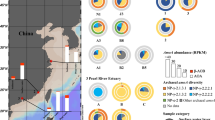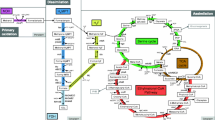Abstract
Flooded rice fields are important sources of atmospheric methane. Aerobic methanotrophs living in the vicinity of rice roots oxidize methane and act as environmental filters. Here, we present genome characteristics of a gammaproteobacterial methanotroph, isolate Sn10-6, which was isolated from a rice rhizosphere of a flooded field in India. Sn10-6 has been identified as a member of a putative novel genus and species within the family Methylococcaceae (Type I methanotrophs). The draft genome of Sn10-6 showed pathways for the following: methane oxidation, formaldehyde assimilation (RuMP), nitrogen fixation, conversion of nitrite to nitrous oxide, and other interesting genes including the ones responsible for survival in the rhizosphere environment. The majority of genes found in this genome were most similar to Methylovulum miyakonese which is a forest isolate. This draft genome provided insight into the physiology, ecology, and phylogeny of this gammaproteobacterial methanotroph.


Similar content being viewed by others
References
Bachelet D, Neue H-U (1993) Methane emissions from wetland rice areas of Asia. Chemosphere 26:219–237
Conrad R (2009) The global methane cycle: recent advances in understanding the microbial processes involved. Environ Microbiol Rep 1:285–292
Hanson RS, Hanson TE (1996) Methanotrophic bacteria. Microbiol Mol Biol Rev 60:439–471
Islam T, Jensen S, Reigstad LJ, Larsen Ø, Birkeland N-K (2008) Methane oxidation at 55°C and pH 2 by a thermoacidophilic bacterium belonging to the Verrucomicrobia phylum. Proc Natl Acad Sci U S A 105:300–304
Pol A, Heijmans K, Harhangi HR, Tedesco D, Jetten MSM, Camp HJMOd (2007) Methanotrophy below pH 1 by a new Verrucomicrobia species. Nature 450:874–878
Dianou D, Ueno C, Ogiso T, Kimura M, Asakawa S (2012) Diversity of cultivable methane-oxidizing bacteria in microsites of a rice paddy field: investigation by cultivation method and fluorescence in situ hybridization (FISH). Microbes Environ 27:278–287
Ferrando L, Tarlera S (2009) Activity and diversity of methanotrophs in the soil-water interface and rhizospheric soil from a flooded temperate rice field. J Appl Microbiol 106:306–316
Geymonat E, Ferrando L, Tarlera SE (2011) Methylogaea oryzae gen. nov., sp. nov., a mesophilic methanotroph isolated from a rice paddy field. Int J Syst Evol Microbiol 61:2568–2572
Ogiso T, Ueno C, Dianou D, Huy TV, Katayama A, Kimura M, Asakawa S (2012) Methylomonas koyamae sp. nov., a type I methane-oxidizing bacterium from floodwater of a rice paddy field. Int J Syst Evol Microbiol 62:1832–1837
Chevreux B, Wetter T, Suhai S (1999) Genome sequence assembly using trace signals and additional sequence information. Computer Science and Biology Proceedings of the German Conference on Bioinformatics (GCB), vol. 99, Hanover, pp. 45–56.
Aziz RK, Bartels D, Best AA, DeJongh M, Disz T, Edwards RA, Formsma K, Gerdes S, Glass EM, Kubal M, Meyer F, Olsen GJ, Olson R, Osterman AL, Overbeek RA, McNeil LK, Paarmann D, Paczian T, Parrello B, Pusch GD, Reich C, Stevens R, Vassieva O, Vonstein V, Wilke A, Zagnitko O (2008) The RAST Server: rapid annotations using subsystems technology. BMC Genomics 9:75
Overbeek R, Olson R, Pusch GD, Olsen GJ, Davis JJ, Disz T, Edwards RA, Gerdes S, Parrello B, Shukla M, Vonstein V, Wattam AR, Xia F, Stevens R (2014) The SEED and the Rapid Annotation of microbial genomes using Subsystems Technology (RAST). Nucleic Acids Res 42:D206–214
Hamilton R, Kits KD, Ramonovskaya VA, Rozova ON, Yurimoto H, Iguchi H, Khmelenina VN, Sakai Y, Dunfield PF, Klotz MG, Knief C, Camp HJMO, Jetten MSM, Bringel F, Vuilleumier S, Svenning MM, Shapiro N, Woyke T, Trotsenko YA, Stein LY, Kalyuzhnayaa MG (2015) Draft genomes of gammaproteobacterial methanotrophs isolated from terrestrial ecosystems. Genome Announc 3:1–3
Kalyuzhnaya MG, Korotkova N, Crowther G, Marx CJ, Lidstrom ME, Chistoserdova L (2005) Analysis of gene islands involved in methanopterin-linked C1 transfer reactions reveals new functions and provides evolutionary insights. J Bacteriol 187:4607–4614
Vuilleumier S, Khmelenina VN, Bringel F, Reshetnikov AS, Lajus A, Mangenot S, Rouy Z, Op den Camp HJ, Jetten MS, Dispirito AA, Dunfield P, Klotz MG, Semrau JD, Stein LY, Barbe V, Medigue C, Trotsenko YA, Kalyuzhnaya MG (2012) Genome sequence of the haloalkaliphilic methanotrophic bacterium Methylomicrobium alcaliphilum 20Z. J Bacteriol 194:551–552
Boden R, Cunliffe M, Scanlan J, Moussard H, Kits KD, Klotz MG, Jetten MS, Vuilleumier S, Han J, Peters L, Mikhailova N, Teshima H, Tapia R, Kyrpides N, Ivanova N, Pagani I, Cheng JF, Goodwin L, Han C, Hauser L, Land ML, Lapidus A, Lucas S, Pitluck S, Woyke T, Stein L, Murrell JC (2011) Complete genome sequence of the aerobic marine methanotroph Methylomonas methanica MC09. J Bacteriol 193:7001–7002
Aizenman E, Engelberg-Kulkat H, Glaser G (1996) An Escherichia coli chromosomal "addiction module" regulated by 3′,5′-bispyrophosphate: a model for programmed bacterial cell death and differentiation. Proc Natl Acad Sci USA 93:6059–6063
Katsuhiko K, Hanaoka F, Burley S (2003) Crystal structure of the MazE/MazF complex: molecular bases of antidote-toxin recognition. Mol Cell 11:875–884
Roslev P, King GM (1995) Aerobic and anaerobic starvation metabolism in methanotrophic bacteria. Appl Environ Microbiol 61:1563–1570
Acknowledgments
This work was supported by Department of Biotechnology under the DBT BioCARe programme (BT/BioCARe/06/840/2012) sanctioned to M. C. R and fellowship sanctioned to P. S. P. is acknowledged. CSIR research fellowship to Preeti Arora and Soham Pore is sincerely acknowledged.
Nucleotide sequence accession number
The draft genome sequence of Methylococcaceae bacterium strain Sn10-6 is deposited in the GenBank database under the accession number LAJX00000000.1 and the bioproject is registered as PRJNA278928.
Author information
Authors and Affiliations
Corresponding author
Rights and permissions
About this article
Cite this article
Rahalkar, M.C., Pandit, P.S., Dhakephalkar, P.K. et al. Genome Characteristics of a Novel Type I Methanotroph (Sn10-6) Isolated from a Flooded Indian Rice Field. Microb Ecol 71, 519–523 (2016). https://doi.org/10.1007/s00248-015-0699-z
Received:
Accepted:
Published:
Issue Date:
DOI: https://doi.org/10.1007/s00248-015-0699-z




